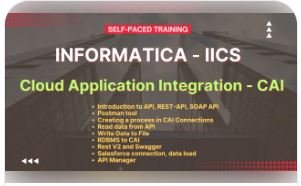Informatica IDMC/IICS interview questions and answers
41. What is pagination?
Pagination, also known as paging, is the process of dividing a document into discrete pages, either electronic pages or printed pages.
How to do pagination in IICS web service: In IICS Webservice, while connecting to REST API to retrieve data for all the pages, what to mention in “End Of Response Expression” so that once data has been retrieved REST API call stops.
42. What is a Process Object in IICS?
A process object is a set of structured data that enables you to handle data sent to or returned from a service. Process Designer generates process objects based on the event sources and event targets defined for each connection. These process objects are available in processes that access the connection.
43. How and where IICS metadata will be stored?
Unlike PowerCenter, all the information in Informatica Cloud is stored on the server maintained by the Informatica and the user does not have access to the repository database. Hence, it is not possible to use any SQL query to retrieve the information like in Informatica PowerCenter.
Informatica Cloud (IICS) provides the public REST APIs for accessing the metadata for their respective Org. One can use the IICS CDI REST V2 connector OR CAI to connect with those APIs to fetch the information.
One can also use third-party tools like POSTMAN to connect with those APIs.
44. How would you get the definition of a database table in a CAI Process?
We can retrieve the data set of DB table rows using a process in Cloud Application Integration, using JDBC_IC Connector.
45. What is Message Queue?
A message queue is a form of asynchronous service-to-service communication used in serverless and microservices architectures. Messages are stored on the queue until they are processed and deleted. Each message is processed only once, by a single consumer. Message queues can be used to decouple heavyweight processing, to buffer or batch work, and to smooth spiky workloads.
Use the messaging options in Application Integration according to your business needs. Use the built-in JMS, AMQP, and AWS SNS/SQS messaging services for queue and topic processing.
46. What is JMS Enqueue Service?
Use the JMS Enqueue Service to send a message to a JMS service, where it will be queued. When the receiving process is ready, the service sends the message to it. The message is sent using the Informatica Secure Agent to communicate with an on-premise service.
The data in the message contains the following components:
Messaging Manager Name: The name of the messaging manager that contains the destination.
Destination Name: The name of the message’s destination.
Format: The format to be serialized to the destination.
Message: The message to be sent to the destination.
Unwrap Root Element: Describes how the process object is serialized when it is sent to the destination.

47. How will you call an external website in a CAI process?
Create a web service transformation to call an external website. In another way create a service connection and app connection to call in a CAI Process.
48. What are the HTTP methods supported in CAI?
IICS CAI will support below HTTP methods.
- GET
- POST
- PATCH
- PUT
- DELETE
49. What is a Swagger file? What is the information it contains?
A Swagger File is a specification for documenting REST APIs; it specifies the format (URL, method, and representation) to describe REST web services. A Swagger file is a JSON file, and you need to have one to configure the IICS REST V2 connection to integrate with any REST API. The Swagger file describes the HTTP method, the parameters required, and the expected response fields for that API.
The Informatica Cloud REST V2 Connector helps to interact with web service applications built on REST architecture. You can use it in a Source transformation, Target transformation, or midstream in a Web Services transformation.
50. What are the service URL and SOAP URL?
SOAP is an XML-encoded messaging system implemented over some transport layer. SOAP is not limited to HTTP for transport while REST is by its nature. The fact you can HTTP for transport for SOAP via URLs and structure those URLs however you want is inconsequential. Also, the fact that most SOAP APIs are probably mostly implemented across HTTP is also irrelevant.
REST is a concept of using the HTTP verbs (PUT, GET, POST, etc.) and response codes as they are intended as the protocol to access and control resources. This includes for creation, modification, deletion, etc. of those resources.
The structure of a SOAP URL might in fact look exactly like a REST API, but with REST, the structure should strongly reflect the logical structure of the resource. You don’t have to be fully RESTful, but if not, your REST API wouldn’t be developer-friendly. SOAP isn’t necessarily required to have nice URLs that reflect data structure as you can provide a WSDL which outlines and can describe the soap services available with just about any URL structure you use. In fact, I’ve seen quite a few totally acceptable SOAP services that had URLs to that seem to be arbitrarily dropped in over the course of time, not reflecting any type of structure.
51. What is WSDL (Web Services Description Language File)?
Web Services Description Language (WSDL) files contain the XML descriptions of the web services, formats of the SOAP requests and responses, and all parameters.
52. What is OAuth authentication?
OAuth is an Open Authorization standard for access delegation, commonly used as a way for internet users to grant websites or applications access to their information on other websites but without giving them the passwords.
53. What is OAuth 2.0?
OAuth 2.0, which stands for “Open Authorization”, is a standard designed to allow a website or application to access resources hosted by other web apps on behalf of a user. It replaced OAuth 1.0 in 2012 and is now the de facto industry standard for online authorization. OAuth 2.0 provides consented access and restricts actions of what the client app can perform on resources on behalf of the user, without ever sharing the user’s credentials.
Although the web is the main platform for OAuth 2, the specification also describes how to handle this kind of delegated access to other client types (browser-based applications, server-side web applications, native/mobile apps, connected devices, etc..)
54. What is authorization and Authentication?
Authorization: is the process of giving permission or authority
Authentication: is the process of verifying the identity of a user
55. What is the use of file connectors in IICS?
The File Connector provides connectivity between Application Integration and file systems so you can monitor file systems for new files, move files, read and write content from files, and select options to handle processed files. You might use the File Connector, for example, to write log files needed as part of a larger integration, or to monitor a file system for new .csv files, read the delimited content from the files, and use the generated XML in a set of process objects.
When you create event sources and event targets with the File Connector, the Process Designer also generates a set of process objects you can access to obtain file information, such as the number of records or file size.
The File Connector runs on an Informatica Secure Agent.
56. What are the capabilities of a File connector?
The File Connector allows you to read and write file content, including text, delimited file content, XML, and JSON. Using one of the configurable event sources or event targets, you can:
- Monitor a file folder and process files when they are added to a folder.
- Perform file operations like move or delete.
- Parse the contents of delimited files to create process objects and make the contents available for use in Process Designer.
- Create event services (event targets) that can be called from Process Designer.
- Serialize a set of process objects in a delimited format and save to a file.
- Serialize process objects to XML/JSON format.
- Write and read text content to a file.
- Write and read binary content to and from files using a binary or attachment format.
- Parse JSON and XML files and convert them to a set of process objects.
57. What are CAI assets, and why are they important?
CAI assets are reusable components like processes, service connectors, and connections. They are important because they promote reusability and efficiency in integration projects.
58. Provide an example of a business scenario where CAI can be used.
CAI can be used to automate the order-to-cash process, where orders from an e-commerce application are integrated with the inventory and shipping systems.
59. Describe the relationship between the Application Integration Console, API Manager, and API Portal in CAI
The Application Integration Console is used to design integration processes, while the API Manager manages APIs created from these processes. The API Portal provides a user-friendly interface for discovering and consuming these APIs.
60. How does CAI support organizations in adhering to data privacy and compliance regulations?
CAI can enforce data privacy and compliance by providing features like data masking and encryption, ensuring sensitive information is handled securely.
Enroll for Informatica IICS Cloud Data Integration(CAI) – Self-Paced courses
![]()



